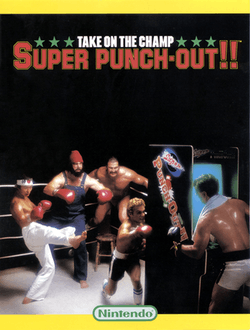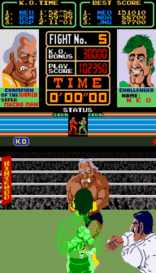Super Punch-Out!! (arcade game)
| Super Punch-Out!! | |
|---|---|
 Arcade flyer of Super Punch-Out!!. | |
| Developer(s) |
Nintendo IRD Elite Systems |
| Publisher(s) | |
| Producer(s) | Genyo Takeda |
| Designer(s) | Genyo Takeda |
| Platform(s) | Arcade, Amstrad CPC,[1] Commodore 16, Commodore 64,[2] Commodore plus/4, MS-DOS, ZX Spectrum[3] |
| Release date(s) |
Arcade Commodore 64 Amstrad CPC
ZX Spectrum
Commodore 16
Commodore plus/4
MS-DOS
|
| Genre(s) | Sports |
| Mode(s) | Single Player |
| CPU | 1x Z80A @ 4 MHz |
| Sound |
Sound CPU: N2A03 @ 1.789772 MHz Sound Chips: N2A03 @ 1.789772 MHz, VLM5030 @ 3.58 MHz |
| Display | Horizontally oriented, 256 × 224, 1025 palette colors, 60 Hz refresh rate |
Super Punch-Out!! (スーパーパンチアウト!! Sūpā Panchi-Auto!!) is a 1984 arcade game by Nintendo. It is a boxing game with the same gameplay and digitized speech of its arcade precursor, Punch-Out!!. This second game in the Punch-Out!! series introduced recurring video games characters such as Bear Hugger, Dragon Chan, Vodka Drunkenski (whose name was changed to Soda Popinski in later releases), Great Tiger and Super Macho Man.
Gameplay

As in the original Punch-Out!!, the player assumes the role of a green-haired boxer (later known as Little Mac in the NES versions),[4] known by three initials, who works through the ranks of the WVBA (World Video Boxing Association). During matches, the player's boxer is viewed from behind as a wireframe (so the opponents can be seen). The player must time his punches, dodges and blocks in order to defeat the opposing boxer. Hints are given as to the opponent's next move by subtle eye changes (the white of the eyes turn from white to yellow), but the player must ultimately predict what moves the opponent will make and react appropriately.
Once the player defeats the final opponent, the player will win the Heavyweight Belt, then defend it against the same characters that he has already beaten. Each successive time they are met, the opponents are harder and quicker. For each opponent, the player must knock them out within three minutes (three knockdowns guarantees a TKO, although the opponents will sometimes stay down on the first or second one). After the player loses, the winning opponent comes forward and taunts the player.
The game is housed in a modified upright cabinet. Like the previous game, it requires two monitors, one atop the other, for the game's display. The top monitor is used to display statistics while the bottom one is the main game display. Apart from this, the game is more or less a standard upright. The game has a joystick and three buttons. Two buttons control left and right punches, one for each arm. One button delivers an uppercut or knockout blow, but it only works when the super meter (also known as the KO meter or power meter) is full. The super meter is filled by landing successful punches. It is drained when the player fails to block or dodge an attack, or if the player is knocked down. Unlike the original Punch-Out!!, Super-Punch-Out!! also featured a joystick which could be pulled straight up from the panel, allowing the player to duck opponents' punches.
Ports and related releases
Frank Bruno's Boxing
| Reception | ||||||||||||||||||
|---|---|---|---|---|---|---|---|---|---|---|---|---|---|---|---|---|---|---|
| ||||||||||||||||||
An unlicensed version of it was released for the Commodore 64,[2] the ZX Spectrum,[12] the Amstrad CPC,[1] and the Commodore Plus/4 [13] titled Frank Bruno's Boxing. It was developed and published by Elite Systems exclusively in Europe. Instead of the nameable wire boxer, real-life boxer Frank Bruno stars as the protagonist of the game. Only the first three opponents of the Super Punch-Out!! arcade were included in the game; however, their names were changed. Bear Hugger was renamed "Canadian Crusher", Dragon Chan was renamed "Fling Long Chop" and Vodka Drunkenski was renamed "Andra Puncharedov". Five exclusive characters were added to the game: Tribal Trouble, Frenchie France, Raviolo Mafiosi, Antipodean Andy and Peter Perfect. This version of the game featured a KO meter, which was an early version of the Super meter used in modern fighting games, allowing a more powerful punch to be thrown when the bar was filled.[6] Elite Systems later re-released the game as Frank Bruno's World Championship Boxing on their Encore budget label to coincide with the Mike Tyson vs. Frank Bruno bout of 1989.
Others
Great Tiger, Super Macho Man and Vodka Drunkenski later appeared in the Nintendo Entertainment System version of Punch-Out!! The last of these three characters was renamed "Soda Popinski" in order to eliminate direct alcohol references in a child/family-friendly game; however, he is depicted as drinking between rounds, and several of his taunts refer obliquely to drunkenness and drunk driving. Bear Hugger, Dragon Chan and Super Macho Man later appeared in the official home version of Super Punch-Out!! for the Super Nintendo Entertainment System.
The Super Punch-Out!! arcade inspired the development and release of Super Punch-Out!! for the Super Nintendo Entertainment System console in 1994. Several elements, such as opponents, were slightly changed for this version. Characters from both Punch-Out!! arcade games were featured in the game with basically the same looks and attacks. This version is the closest arcade-to-home console translation in the series; however, it isn't a direct port.
As in the original Punch-Out!! arcade, Mario, Luigi, Donkey Kong and Donkey Kong Junior all appear in the audience part of the Super Punch-Out!! arcade. Also, one of the victory tunes heard in the Super Punch-Out!! arcade was later used in Nintendo's Baseball for the NES as the home run theme.
References
- 1 2 "CPC Zone : The Amstrad CPC Resource : : Frank Brunos Boxing by Elite Systems Ltd for the Amstrad CPC/GX 4000". CPC Zone. Retrieved 2009-05-18.
- 1 2 "STADIUM 64 - Game Infos: Frank Bruno's Boxing". STADIUM 64. Archived from the original on October 28, 2007. Retrieved 2009-02-24.
- ↑ "World of Spectrum - Sinclair Infoseek - Frank Bruno's Big Box". World of Spectrum. Retrieved 2009-02-23.
- ↑ One of the Origin/Game Settings Tips about Little Mac's origin and All-Star Mode for Super Smash bros. for Nintendo 3DS / Wii U reveals that Little Mac was actually debut in the 1984 Punch-Out!! arcade
- ↑ "Archive - Magazine viewer". World of Spectrum. Retrieved 2013-02-18.
- 1 2 "Archive - Magazine viewer". World of Spectrum. Retrieved 2013-02-18.
- ↑ "Archive - Magazine viewer". World of Spectrum. Retrieved 2013-02-18.
- ↑ "Archive - Magazine viewer". World of Spectrum. Retrieved 2013-02-18.
- ↑ "Archive - Magazine viewer". World of Spectrum. Retrieved 2013-02-18.
- ↑ "Archive - Magazine viewer". World of Spectrum. Retrieved 2013-02-18.
- ↑ "Archive - Magazine viewer". World of Spectrum. Retrieved 2013-02-18.
- ↑ "World of Spectrum - Sinclair Infoseek - Frank Bruno's Boxing". World of Spectrum. Retrieved 2009-02-23.
- ↑ "Frank Bruno's Boxing". Commodore Plus/4 World. Retrieved 27 April 2016.
External links
- Super Punch-Out!! at the Killer List of Videogames
- Super Punch-Out!! at arcade-history
- Super Punch-Out!! at NinDB